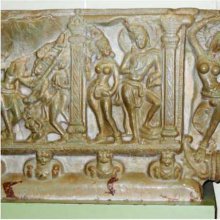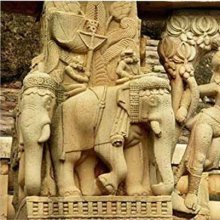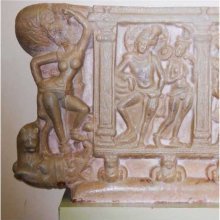Shalabhanjika, Śālabhañjikā, Shala-bhanjika: 12 definitions
Introduction:
Shalabhanjika means something in Hinduism, Sanskrit, Jainism, Prakrit. If you want to know the exact meaning, history, etymology or English translation of this term then check out the descriptions on this page. Add your comment or reference to a book if you want to contribute to this summary article.
The Sanskrit term Śālabhañjikā can be transliterated into English as Salabhanjika or Shalabhanjika, using the IAST transliteration scheme (?).
Images (photo gallery)
(+1 more images available)
In Hinduism
Purana and Itihasa (epic history)
Source: archive.org: Shiva Purana - English TranslationŚālabhañjikā (शालभञ्जिका) refers to a “wonderfully fine statuette”, which is mentioned as an item of wealth in order to demonstrate the wicked nature of gambling (durodara), according to the Śivapurāṇa 2.1.17.—Accordingly, “[...] O mistress! where is that gambling rogue of a son, Guṇanidhi? Or let it be. Why should I ask for him? [...] Where is that wonderfully fine statuette (śālabhañjikā) of a lady lighting a lamp, shining like the moon (candrakānti), and brought from the hilly province (parvatadeśīya)? [...]”.

The Purana (पुराण, purāṇas) refers to Sanskrit literature preserving ancient India’s vast cultural history, including historical legends, religious ceremonies, various arts and sciences. The eighteen mahapuranas total over 400,000 shlokas (metrical couplets) and date to at least several centuries BCE.
Chandas (prosody, study of Sanskrit metres)
Source: Journal of the University of Bombay Volume V: Apabhramsa metres (2)1) Śālabhañjikā (शालभञ्जिका) (also called Pathyā) is the name of a catuṣpadi metre (as popularly employed by the Apabhraṃśa bards), as discussed in books such as the Chandonuśāsana, Kavidarpaṇa, Vṛttajātisamuccaya and Svayambhūchandas.—Pathyā (Śālabhañjikā) has 20 mātrās in each of its four lines, divided into the groups of 4, 4, 4, 5 and [IS] mātrās.
2) Śālabhañjikā (शालभञ्जिका) refers to another catuṣpadi metre, having 24 mātrās in each of its four lines, divided into the groups of 3, 3, 4, 4, 4, 3 and 3 mātrās.

Chandas (छन्दस्) refers to Sanskrit prosody and represents one of the six Vedangas (auxiliary disciplines belonging to the study of the Vedas). The science of prosody (chandas-shastra) focusses on the study of the poetic meters such as the commonly known twenty-six metres mentioned by Pingalas.
In Jainism
General definition (in Jainism)
Source: Singhi Jain Series: Ratnaprabha-suri’s Kuvalayamala-kathaŚālabhañjikā (शालभञ्जिका) refers to a type of (sculptured) women used in decorating the samavasaraṇa of ancient India, according to Uddyotanasūri in his 8th-century Kuvalayamālā (a Prakrit Campū, similar to Kāvya poetry).—Page 96.27-33 and p. 97.1-24: Here is a description of samavasaraṇa consisting of enclosures, gateways, beautified by figures of Śālabhañjikā women and in the centre of all was placed on a high terrain the throne of the Tīrthaṃkara furnished with three parasols, fly-whisks, a rain of heavenly flowers, an aśoka tree and halo.

Jainism is an Indian religion of Dharma whose doctrine revolves around harmlessness (ahimsa) towards every living being. The two major branches (Digambara and Svetambara) of Jainism stimulate self-control (or, shramana, ‘self-reliance’) and spiritual development through a path of peace for the soul to progess to the ultimate goal.
Languages of India and abroad
Sanskrit dictionary
Source: DDSA: The practical Sanskrit-English dictionaryŚālabhañjikā (शालभञ्जिका).—
1) a doll, puppet, statue; Vb.1; N.2.83; रचिता तोरणशालभञ्जिकेव (racitā toraṇaśālabhañjikeva) Bu. Ch.5.52.
2) a courtezan, harlot.
Śālabhañjikā is a Sanskrit compound consisting of the terms śāla and bhañjikā (भञ्जिका).
Source: Cologne Digital Sanskrit Dictionaries: Edgerton Buddhist Hybrid Sanskrit DictionarySālabhañjikā (सालभञ्जिका) or Sālabhañjaka.—(1) m. or nt., breaking of the sāl-branch, said of the Bodhisattva's mother in giving birth to him: °kaṃ ca kariṣyati Mahāvastu ii.18.9 (prose); (2) f., breaking of sāl-branches, name of a festival: Avadāna-śataka i.302.6, see s.v. parvan.
Source: Cologne Digital Sanskrit Dictionaries: Shabda-Sagara Sanskrit-English DictionaryŚālabhañjikā (शालभञ्जिका).—f.
(-kā) 1. A doll, a puppet. 2. A whore, a harlot. E. kan added to the following.
--- OR ---
Sālabhañjikā (सालभञ्जिका).—f.
(-kā) 1. A doll, a puppet. 2. A harlot. E. sāla the Sal tree or its wood, bhañj to rub, ṇvul aff., fem. form.
Source: Cologne Digital Sanskrit Dictionaries: Benfey Sanskrit-English DictionarySālabhañjikā (सालभञ्जिका).—[sāla-bhañj + ikā], f. A doll, a puppet.
Source: Cologne Digital Sanskrit Dictionaries: Cappeller Sanskrit-English DictionaryŚālabhañjikā (शालभञ्जिका).—[feminine] statue.
Source: Cologne Digital Sanskrit Dictionaries: Monier-Williams Sanskrit-English Dictionary1) Śālabhañjikā (शालभञ्जिका):—[=śāla-bhañjikā] [from śāla] f. an image or figure made of Śāl wood, [Kathāsaritsāgara; Rājataraṅgiṇī]
2) [v.s. ...] a kind of game played in the east of India, [Uṇādi-sūtra ii, 32 [Scholiast or Commentator]]
3) [v.s. ...] a harlot, courtezan, [cf. Lexicographers, esp. such as amarasiṃha, halāyudha, hemacandra, etc.]
Source: Cologne Digital Sanskrit Dictionaries: Yates Sanskrit-English Dictionary1) Śālabhañjikā (शालभञ्जिका):—[śāla-bhañjikā] (kā) 1. f. A doll; a whore.
2) Sālabhañjikā (सालभञ्जिका):—[sāla-bhañjikā] (kā) 1. f. A doll, a puppet.
Source: DDSA: Paia-sadda-mahannavo; a comprehensive Prakrit Hindi dictionary (S)Śālabhañjikā (शालभञ्जिका) in the Sanskrit language is related to the Prakrit words: Sālahaṃjiyā, Sālahaṃjī.
[Sanskrit to German]
Sanskrit, also spelled संस्कृतम् (saṃskṛtam), is an ancient language of India commonly seen as the grandmother of the Indo-European language family (even English!). Closely allied with Prakrit and Pali, Sanskrit is more exhaustive in both grammar and terms and has the most extensive collection of literature in the world, greatly surpassing its sister-languages Greek and Latin.
See also (Relevant definitions)
Partial matches: Shala, Bhanjika, Cala.
Starts with: Shalabhanjikaprakhya, Shalabhanjikaya.
Ends with: Kelishalabhanjika, Viddhashalabhanjika.
Full-text (+5): Shalabhanji, Shalabhanjikaprakhya, Shalanki, Calapancikai, Salapancikai, Kelishalabhanjika, Viddhashalabhanjika, Shalabhanjikaya, Bhanjika, Salahamjiya, Salahamji, Salabhanjaka, Jayalakshmi, Jayashri, Bhanjaka, Heavenly flower, Bhamandala, Halo, Parvan, Vaijayanta.
Relevant text
Search found 5 books and stories containing Shalabhanjika, Śālabhañjikā, Shala-bhanjika, Śāla-bhañjikā, Salabhanjika, Sala-bhanjika, Sālabhañjikā, Sāla-bhañjikā; (plurals include: Shalabhanjikas, Śālabhañjikās, bhanjikas, bhañjikās, Salabhanjikas, Sālabhañjikās). You can also click to the full overview containing English textual excerpts. Below are direct links for the most relevant articles:
Amaravati Art in the Context of Andhra Archaeology (by Sreyashi Ray chowdhuri)
The Birth of Buddha < [Chapter 3 - Amarāvatī and the Formative Stage of the Buddhist Art]
Natyashastra (English) (by Bharata-muni)
Harshacharita (socio-cultural Study) (by Mrs. Nandita Sarmah)
1. Similarities (8): Art and Architecture < [Chapter 8 - Comparative Society as described in the Kādambarī and the Harṣacarita]
16. Art and Architecture < [Chapter 6 - Other Socio-Cultural Aspects]
Dramaturgy in the Venisamhara (by Debi Prasad Namasudra)
Ārabhaṭī-vṛtti (fierce fights and outrageous deeds) < [Chapter 4 - Dramaturgy in Veṇīsaṃhāra]
Pallava period (Social and Cultural History) (by S. Krishnamurthy)
Coiffure of Women < [Chapter 4 - Material Culture of the People]





